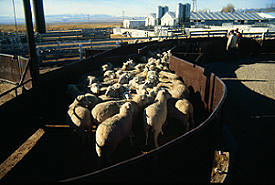Electric Stunning of Sheep

Safety Tips for Workers
- The stunner operator's station must be kept dry.
- Stunning wands should be designed so that they can be
operated by
one hand. Avoid designs where the two electrodes are held
separately in each hand. These increase a shock across the chest
electrocution hazard.
- The operator should wear rubber boots and stand on
non-conductive
plastic grating.
- The restrainer frame and worker walkway structure should be
grounded to a perfect ground. However, the side of the restrainer
that the stunner operator can touch should be covered with
heavy insulating materials such as a plastic meat cutting
board.

Sheep in a crowd pen moving into a single file race.
Electrical
stunning methods used commercially on sheep are effective and
induce instantaneous insensibility. A minimum of 1 amp must be passed
through the animal's brain to reliably induce insensibility (Gregory and
Wotton, 1984).
- To produce instantaneous, painless unconsciousness, sufficient amperage
(current) must pass through the animal's brain to induce an epileptic
seizure. Insufficient amperage or a current path that fails to go through
the brain will be painful for the animal. It will feel a large electric
shock or heart attack symptoms, even though it may be paralyzed and unable
to move. When electric stunning is done correctly, the animal will feel
nothing.
- There are two types of electric stunning, head only and cardiac
arrest stunning, which stops the heart. Most large plants use cardiac
arrest head to back or head to side of body stunning. It produces a still
carcass that is safer and easier to bleed. Cardiac arrest stunning
requires the use of a restraining device to prevent the animal from
falling away from the stunning wand before it receives the complete stun.
Cardiac arrest stunning kills the animal by electrocution. Head only
stunning is reversible. Sheep which are stunned with a head
only stunner must be bled within a maximum interval of 30 seconds to
prevent them from regaining consciousness. An interval of 10 to 17
seconds is recommended.
- When cardiac arrest stunning is used, one electrode must be
placed on
either the forehead or in the hollow behind the ears, and the other
electrode is placed on either the back or the side of the body. The head
electrode should not be allowed to slide back onto the neck. When head
only stunning is used, the electrodes may be either placed on the forehead
or clamped over around the sides of the head like ear muffs. The
stunning wand must be applied to the animal
for two to three seconds to stun properly. Stunners should be
equipped with a timer.
- Meat packers should use amperage, voltage and frequency settings
which will reliably induce unconsciousness. Both properly and improperly
stunned cardiac arrested animals can look similar (Gilbert and Devine,
1991). Current flow through the spine masks the epileptic seizure. If
there is any question, electrical parameters should be verified by
scientifically valid measurements.
- To prevent bloodspots in the meat and pain to the animal, the wand
must be pressed against the animal before the button is pushed. The
operator must be careful not to break and make the circuit during the
stun. This causes the animal's muscles to tense up more than once and
bloodspots may increase. Stunning wands and wiring should be checked
often for electrical continuity. A worn switch may break the circuit
enough to cause bloodspots. Electrodes must be kept clean to provide a
good electrical contact. Operators must never double stun animals or use
the stunning wand as a prod.
- Modern stunning circuits use a constant amperage design. The
amperage is set and the voltage varies with sheep resistance.
Older style circuits are voltage regulated. These circuits are inferior
because they allow large amperage surges which can fracture bones and cause
bloodsplash. The distance between the head electrode and the back electrode
should not exceed 14 inches. The most modern sheep
stunners from New Zealand utilize water jets to conduct electricity down
through the wool.
 References :
References : Electric Stunning
Electric Stunning
 Grandin, T. 1985/1986
Cardiac Arrest Stunning of Livestock and
Poultry
Grandin, T. 1985/1986
Cardiac Arrest Stunning of Livestock and
Poultry
in:M.W.Fox and L.D.Mickley (Editors)
Advances In
Animal Welfare Science
Martinus Nijhoff, The Hague, The
Netherlands
 Grandin, T. 1994
Euthanasia and Slaughter of
Livestock
Grandin, T. 1994
Euthanasia and Slaughter of
Livestock
Journal of American Veterinary Medical
Association
volume 204 : 1354 - 1360





Grandin, T. 1985/1986
Grandin, T. 1994